

Launching Math Centers - The Brown Bag Teacher. Math Centers are *the* most fun part of 1st grade learning.
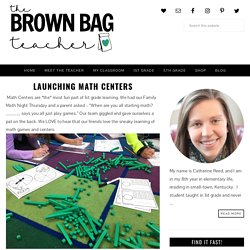
6 Easy Steps To Running Effective Math Centers In Your Classroom. Be a guided math guru half day k 2. Levels of strategies ppt 2 18 2014. The University of Arizona - Institute for Mathematics & Education. The Common Core State Standards in mathematics were built on progressions: narrative documents describing the progression of a topic across a number of grade levels, informed both by research on children's cognitive development and by the logical structure of mathematics. These documents were spliced together and then sliced into grade level standards. From that point on the work focused on refining and revising the grade level standards. The early drafts of the progressions documents no longer correspond to the current state of the standards. It is important to produce up-to-date versions of the progressions documents. They can explain why standards are sequenced the way they are, point out cognitive difficulties and pedagogical solutions, and give more detail on particularly knotty areas of the mathematics.
This project is organizing the writing of final versions of the progressions documents for the K–12 Common Core State Standards. Numeracy Development Projects Books. There are several small errors in the initial print version of Book 5 which have been corrected in the latest online version.
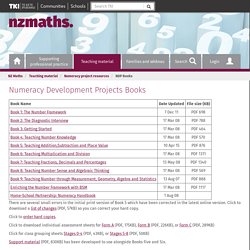
Click to download a list of changes (PDF, 57KB) so you can correct your hard copy. Click to order hard copies. Click to download individual assessment sheets for Form A (PDF, 175KB), Form B (PDF, 226KB), or Form C (PDF, 289KB) Number Strategies: Level 1. The key idea of number strategies at level 1 is that counting can be used to solve number problems.
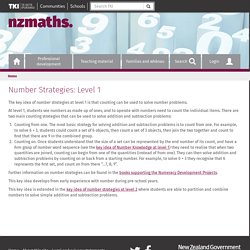
At level 1, students see numbers as made up of ones, and to operate with numbers need to count the individual items. There are two main counting strategies that can be used to solve addition and subtraction problems: Counting from one. The most basic strategy for solving addition and subtraction problems is to count from one. For example, to solve 6 + 3, students could count a set of 6 objects, then count a set of 3 objects, then join the two together and count to find that there are 9 in the combined group. Further information on number strategies can be found in the books supporting the Numeracy Development Projects. CRA for Composing and Decomposing Numbers. The Ultimate Guide to Math Centers - Mr Elementary Math. How to Organize Your Math Centers - Mr Elementary Math. 10 classroom routines that get kids talking (and writing) about math strategies. Most kids find it challenging to explain how they solve math problems and to put what they know about math into words.
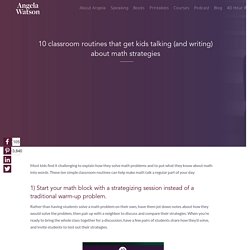
These ten simple classroom routines can help make math talk a regular part of your day: 1) Start your math block with a strategizing session instead of a traditional warm-up problem. Rather than having students solve a math problem on their own, have them jot down notes about how they would solve the problem, then pair up with a neighbor to discuss and compare their strategies. When you’re ready to bring the whole class together for a discussion, have a few pairs of students share how they’d solve, and invite students to test out their strategies. 2) Occasionally ask students to discuss strategies without actually solving the problem. A First for Everything : Reflections on Math Workshop Model.
My district began a push towards differentiated math instruction in the form of ability grouping about 3 years ago.
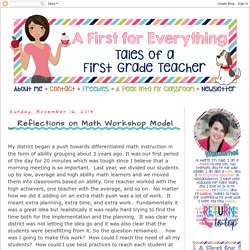
It was our first period of the day for 20 minutes which was tough since I believe that a morning meeting is so important. Last year, we divided our students up by low, average and high ability math learners and we moved them into classrooms based on ability. One teacher worked with the high achievers, one teacher with the average, and so on. Ten-Frame Activity Dice. Dr Nicki - CCSS Math 2nd Grade Critical Areas.mov. Setting Up... Calendar - Elementary Nest. Here we go for number 4 for our Setting Up Series.
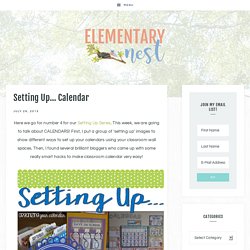
This week, we are going to talk about CALENDARS! First, I put a group of ‘setting up’ images to show different ways to set up your calendars using your classroom wall spaces. Then, I found several brilliant bloggers who came up with some really smart hacks to make classroom calendar very easy! Mathématiques. Banque de problèmes – La mathématique à l'école primaire. Guided Math in 1st Grade - The Brown Bag Teacher. Math Workshop (Part 3) - Teaching in the Tongass. This is the third post in my Math Workshop series.
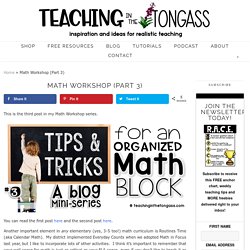
You can read the first post here and the second post here. Another important element in any elementary (yes, 3-5 too!) Guided Math and Workstation Resources - Tunstall's Teaching Tidbits. Gr. 2 Understand Place Value ~ Math Units of Study ~ Instruction ~ School Improvement in Maryland. Unit Overview This unit works with numbers up to 1,000 to further extend student understanding of place value and the relationship between the values of the different places within a number.
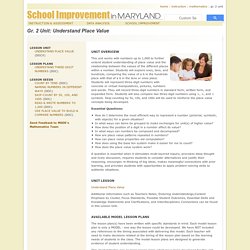
Students will explore ones, tens, and hundreds, comparing the value of a 6 in the hundreds place with that of a 6 in the tens or ones place. Students will represent three-digit numbers with concrete or virtual manipulatives, pictures, numbers and words. They will record three-digit numbers in standard form, written form, and expanded form. Students will also compare two three-digit numbers using >, =, and < symbols. Essential Questions: How do I determine the most efficient way to represent a number (pictorial, symbolic, with objects) for a given situation? Unit Lesson Available Model Lesson Plans The lesson plan(s) have been written with specific standards in mind.
This chart indicates one or more lesson plans which have been developed for this unit. CCSC Alignment: 2.NBT.A.1 CCSC Alignnment: 2.NBT.A.1a.